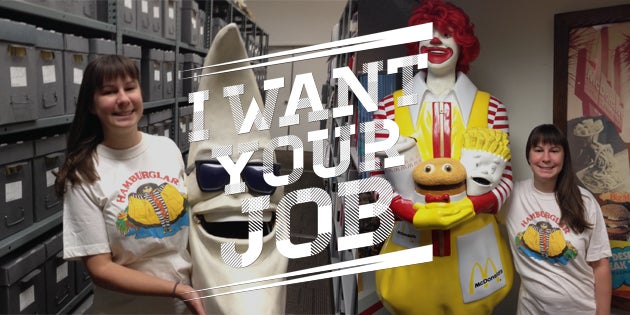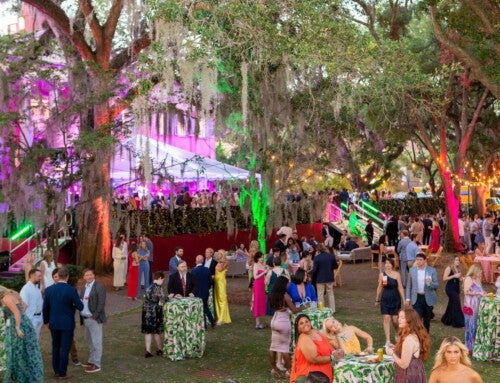Forget what you think you know about archives, because Jessica Farrell’s office is nothing like what you’re picturing. The 2008 graduate, one of two McDonald’s archivists in the world, is based just outside of Chicago in a climate-controlled building which houses McDonald’s entire history. That’s anything from employee uniforms, to McDonaldland character costumes, and Happy Meal toys.
Q: How is your day going?
A: It’s pretty good, I went downtown this morning for the Apple iPhone release and handed out apple pie and apple slices to people waiting in line for the iPhone 6 and 6 Plus. It was a fun way to enhance awareness of McDonald’s accepting Apple Pay at our restaurants soon.
Q: What are your job responsibilities on days when the new iPhone isn’t coming out?
A: Our primary responsibility is to make sure McDonald’s historic materials are preserved. That involves ensuring they’re accounted for, catalogued appropriately, and placed in a climate-controlled area. They’re treated like museum objects. Our other primary responsibility is the research, which takes up most of our time; we field multiple requests every day for any question that you could ever think of about McDonald’s.
RELATED: Check out the McDonald’s #1 Store Museum
We also manage several museum spaces. The first is McDonald’s Corporation’s first restaurant, which is located about 10 minutes from my office in Des Plaines, Ill. The other site is a general history exhibit featuring a replica of Ray Kroc’s (founder of the McDonald Corporation) office at Hamburger University – one of seven global facilities that focus on training, learning and development for McDonald’s restaurant and corporate employees – located at the company’s home office in Oak Brook, Ill. We manage these spaces and give tours to groups of company people and McDonald’s fans from all around the world. We also work with our media teams to cultivate stories about the history of McDonald’s for both external and internal audiences.
In addition to the above, our responsibilities are similar to any other archivists’; picking up collections of material from employees and departments; digitizing material, and managing electronic records. Lastly, we work tirelessly with our Legal colleagues to manage usage rights for any images and even information.
Q: What kinds of materials do you archive?
A: We archive as wide a range of material as possible to compile a comprehensive, historical view of McDonald’s. However, as any archivist will tell you, we can’t keep everything.
We keep every Happy Meal toy that was ever created, tons of ads, packaging, correspondence (usually from company leaders), product development files, company publications, images, oral histories, commercials, meeting records, textiles (like Ronald McDonald’s costumes and crew uniforms), and many other types of records. We lend these materials out to McDonald’s restaurants whenever they have, for example, an anniversary and want to celebrate with nostalgic company artifacts and clothing.
This might sound like “everything,” but most of our records only encompass McDonald’s products and initiatives that were formally introduced in the U.S. market after an extensive testing and development process. There are plenty of projects that are undocumented because they never survived the initial research and development phase.
Q: What is your office like?
A: Our office is in the Chicago suburb of Elk Grove Village, Ill., while the rest of McDonald’s company headquarters are located in Oak Brook, Ill. We have a specialized space because we need so much room for the archives and it needs to be climate controlled. The archive itself isn’t the most interesting visual, as it’s mainly a collection of neatly organized and labeled boxes; it’s what’s in the boxes that are really cool.
Outside the archive stacks we have a reading room, similar to the Special Collections area in the College library, but we don’t have outside researchers come in. My boss and I field all research requests and conduct all the research ourselves.
Q: What is a typical day like for you?
A: It depends on how you define typical! Sometimes I’m doing research all day long, while other days I’m busy giving museum tours. Then, if we have any time at the end of the day after answering our clients’ questions, we catalog what we have in the backlog. Additionally, we are always working on special projects involving digital assets or some aspect of records management, so there are inevitably many meetings and ongoing projects to tackle in those areas.
Q: What’s the craziest thing you’ve seen in the archives?
A: The McDonaldland character memorabilia is interesting to me because the characters evolved a lot over time. The earliest drawings and physical incarnations of them from the ‘70s are very different from how they looked when I was a kid in the late ‘80s and early ‘90s. After looking at so much memorabilia of the characters, in my opinion, the 1970s version of the Hamburglar was a little creepy…albeit in a very cool way! But just like anything else in an archive, it fits within the context of the times. Children’s designs were a lot different in the ‘70s than they are now.
Q: What is it like working with just one other person?
A: I have to say it’s pretty awesome working with just one person. I love being around people and working on a team, but it’s a lot easier to make decisions quickly with just one person. That said, you know, it’s also really hard to prioritize projects with just one person since we can only do a certain amount of work.
I have a million dream projects like instituting a company-wide digital preservation initiative or doing a public-facing history blog, or, every archivists dream – gaining control of our sizeable backlog of unprocessed material. But like any small archival institution, some of these “dream” projects have to take a back seat unless we find a way to perform all basic preservation tasks and still devote time to the extra projects. So the small team structure has its positives and negatives in that sense.
Q: What is your favorite part of your job?
A: One part of it would be getting to do a lot of different things representing the brand, like the Apple pies and slices giveaway at the Apple Store we did today. I don’t often get to do things like that, but when I do it’s a lot of fun.
It’s also pretty cool to work with living donors. McDonald’s started in 1955 so most of our records only go back to the mid-20th century. That means some of the people who joined McDonald’s in the early days are still alive. For example, the other day I received research questions about the McRib sandwich and I got the opportunity to call the first executive chef of McDonald’s, Rene Arend. He invented the McNugget and the McRib and it was really cool to talk to him – he’s like a celebrity to me. If I were working in a Civil War archive, I would never be able to call the soldier who wrote the letters I’m processing!
Q: What is it like working for such a large corporation?
A: I really like it. The diversity at McDonald’s is just incredible. I meet so many unique people from various backgrounds with a million different interests. When you’re in a large corporation like McDonald’s, there’s a position for just about everything. I guess my job is an example of that. When I talk with people I meet outside of work, they are usually surprised to learn that McDonald’s has an archive…but there are all sorts of other unique and interesting positions at the company, too.
It’s also really cool to get to collaborate with all these different people, and to learn how a business this large works. I never considered working for a business until I saw this job, just because most archives exist in an academic setting. However, after I started working here, it blew away all my misconceptions of what working for a big corporation would be like, and so far it’s been an amazing (and fun!) experience.
Q: What motivated your move to Chicago after college?
A: I started working as a student worker in the library’s Special Collections department during my final semester at the College. This was before I knew anything about what an archivist did, but I fell in love with it after that. I went on to work in the Avery Research Center for a couple of years and I got my master’s degree in library and information science while I was working there.
After I earned my master’s I decided I was ready for a new challenge, so I moved to Chicago and got lucky finding this job. I had been visiting Chicago for a few years so I had an idea of what the city would be like, and living here is a lot of fun! There are so many unique cultural institutions here, and I’ve been able to do some volunteer work outside of McDonald’s for some of them, including the Chicago Read/Write Library, a completely volunteer-run community library.
Q: How did you hear about your job?
A: I heard about this job through a listserv. There are a lot of listservs out there for library and information sciences jobs; for example, there’s the Society of American Archivists job listings, ArchivesGig, and local professional organization lists like the Chicago Area Archivists where I live, and in Charleston, there’s a group called CALM – Charleston Archives, Libraries, and Museums. Library schools often post jobs through e-mail newsletters and other forms of communication as well.
Q: How did the College help you prepare for this position?
A: I got my degree in French and Francophone studies with minors in African studies and comparative literature at the College, so my undergraduate studies were extremely interdisciplinary. I was already interested in so many fields, so doing research across those varied fields prepared me well for working in an archive. You’d think that my work would be really focused on McDonald’s, but it’s actually very helpful to know about a lot of different historic and cultural subject matter. The College really laid that foundation for me.
I only got into archives because I was doing research my senior year on the history of the College of Charleston that required me to use Special Collections’ university archives, and I eventually ended up working there. That experience definitely sparked my interest in this as a career path.
RELATED: Learn more about the College’s French and Francophone studies major
Q: What advice would you give to current students interested in archives or library sciences?
A: It’s a tough job market out there, so for those that are interested, I would advise that they start working or volunteering in a library or archive as soon as possible. I would also suggest finding a mentor – one of the most important catalysts for my success was getting advice and guidance from John White, who’s now Dean of libraries at the College. He was my mentor in Special Collections, and there’s no way I would have gotten as far as I have without working with him and having him there to answer my many obsessive and ambitious career questions.







